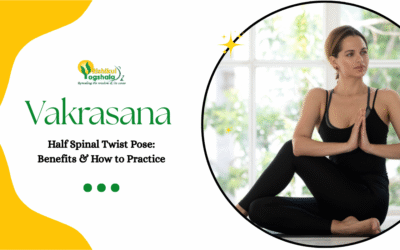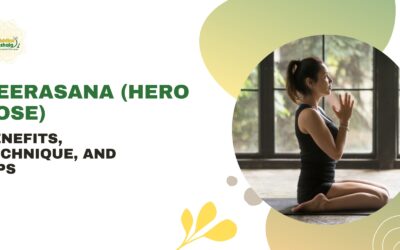What is the origin of the word “Salabhasana”? “Salabha” in Sanskrit refers to locusts. The locust pose in yoga appears to be a simple pose at one glance. The truth is, it takes a lot of muscular effort and flexibility to master this yoga asana. Salabhasana strengthens the muscle groups that arch your back, including the gluteus maximus, the hamstrings, the lower trapezius, the lower back’s quadratus lumborum, and the erector spinae that run the length of the spine.
Don’t squeeze your lumbar region! If you use all of your back muscles rather than just those in your lower back it will help to open your chest and shoulders. The feeling of building muscle and opening up your chest will be excellent for those of us who spend most of our days hunched over computers.
7 Preparatory Poses of The Locust Yoga Pose (Salabhasana Preparatory Poses)
These preparatory poses warm up our bodies in order to enter the more challenging yoga positions, such as the standing poses, backbends, inversions, twists, and forward folds. These postures are even used to help us breathe more easily and explore our thoughts and emotions in both our bodies and minds.
Here are seven preparatory poses for Salabhasana:
- Cobra pose (Bhujangasana)
- Upward-facing dog pose (Urdhva Mukha Svanasana)
- Warrior I pose (Virabhadrasana)
- Cow face pose (Gomukhasana)
- Bridge pose (Setu Bandha Sarvangasana)
- Reclining hero pose (Supta Virasana)
- Hero pose (Virasana)

7 Steps of The Locust Pose
Salabhasana steps involve lying on your stomach, lifting your chest, arms, and legs off the ground, and engaging your core for a gentle backend. The locust pose should be avoided by anyone who experiences severe menstrual issues or who has a prolapsed uterus. The pressure this pose puts on the abdomen may be dangerous for such people. Although the heart is open, the prone position puts pressure on the chest and abdomen, making it unsuitable for those with asthma.
So if you do not come under this category of people, follow these steps to perform the locust pose:
- Lie down on your belly.
- Put your feet together and extend your big toes while pressing down the toenails. This activates your quadriceps.
- Reach out behind you with your hands.
- Rotate your inner thighs and broaden your lower back.
- Raise your legs, chest, and head while you keep your hands lightly on the mat.
- Keep your shoulders rolled back away from the floor.
- Lift your sternum instead of your chin.
Read More – Unlocking Potential: The Physical and Psychic Powers of Locust Pose
5 Tips on Performing The Locust Yoga Pose
Typically, yoga should not be practiced when you are sick, exhausted, in a rush, or under intense stress. Regular yoga practice, especially asanas, should be avoided by women during their periods. Instead, you could practice pranayama and relaxation techniques. Also, avoid doing yoga right after eating.
Here are a few tips for performing the locust pose the right way:
- You can begin performing the Salabhasana pose by lifting just your upper body.
- Then try lifting one of your legs for 30 seconds.
- Swap your legs and hold them for half a minute.
- Remember to reach out with the balls of your feet and your heart.
You could try to place your hip bones on a folded blanket if they feel uncomfortable in any way.
5 Benefits of The Locust Pose Yoga (Benefits of Salabhasana)
Yoga itself is steamed with mental and physical health benefits. The common benefits of yoga asanas are that it stretch your muscles and relieve hidden tension. It is especially beneficial for those who have limited movement throughout their day.
Here’s what the locust yoga pose helps you achieve:
- Stimulates all of your abdominal organs
- Stretches your shoulders and chest
- Stretches the entire front section of your body
- Strengthens your leg muscles, glutes, and back
- Relieves lower back pain and kyphosis
3 Precautions to Be Kept in Mind
Yoga is a flexible routine that is aggravating if you have any muscle or nerve injuries. Yes, it does stretch and all, but imagine stretching a broken or wounded muscle fibre. Yoga never repairs anything; it simply wrings all the nerves and muscles to alleviate tension.
Keep these cautions in mind while attempting the locust yoga pose:
- If you have a back or head injury, you should modify this pose accordingly.
- A neck injury can also aggravate your pain while doing the locust pose. So keep your head neutral (which means look down and do not lift your head). You could also support your neck with a thickly folded blanket.
- No pregnant folks should be attempting this yoga.
3 Variations of The Locust Yoga Pose
The half locust pose is a variation of Salabhasana, where the upper body is lifted.
- The first variation of a half-locust pose is lifting the upper body. The upper back muscles are in focus here, while the hands are interlaced behind you.
- The next variation is lifting both your legs while keeping the upper body on the ground. Remember to keep your palm flat on the floor beneath your thighs or under your forehead.
- The third variation involves performing the second variation and lifting one of your legs at a time.
- Make sure you hold each of these poses for 30 seconds and release the pose slowly and calmly. No rush there. Repeat the routine at least 10 times or as many as you are comfortable doing.
A Final Word: Follow These Expert Tips to Prevent Injury
Experts can challenge themselves with a Salabhasana variation: Bend your knees and place your shins perpendicular to the floor rather than stretching the legs straight back from the pelvis. Lift the knees as high off the floor as you can while lifting the upper body, including the head, arms, and upper body.
You may strain your lower back if you simply focus on going high. So, distribute your backbend through the lower, middle, and upper back. This will help in opening and stretching your chest.
Also, do not ever bend your knees, as it can add pressure on your lower back. Bent knees put too much weight on the lower vertebrae.

Here are some yoga asanas related to Salabhasana:
- Dhanurasana (Bow pose)
- Bhujangasana (Cobra pose)
- Urdhva Dhanurasana (Upward bow or wheel pose)
Now, it’s time to stretch your glutes and back muscles!
Incorporating this pose into your practice can lead to significant improvements in overall well-being. For those interested in deepening their yoga journey, consider enrolling in a yoga teacher training program. Rishikul Yogshala, a leading Yoga school in Rishikesh, offers comprehensive courses like the 200 Hour Yoga TTC In Rishikesh, 300 Hour Yoga Teacher Training In Rishikesh, and 500 Hour Yoga Teacher Training Rishikesh. These programs are designed to help you master your practice and share the transformative power of yoga with others.












